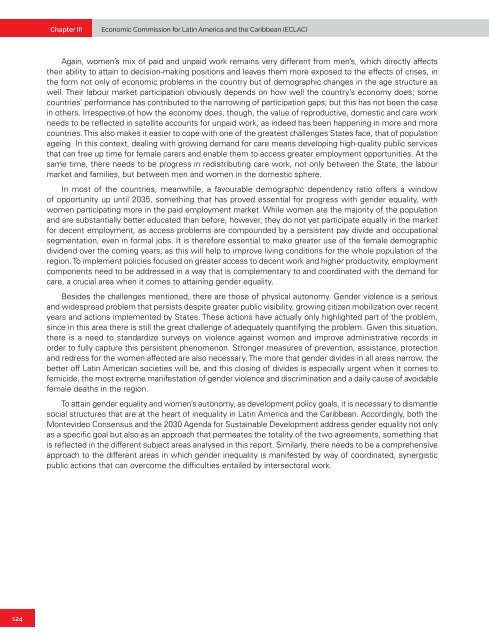Draft first regional report on the implementation of the Montevideo Consensus on Population and Development
This draft report seeks to give an account of progress in the implementation of the priority measures of the Montevideo Consensus on Population and Development in the region, as well as the differences between countries in terms of the degree of implementation. By highlighting relevant national experiences, it also seeks to facilitate the exchange of good practices among countries so that they can benefit from each other in their efforts to advance the implementation of the actions of the Montevideo Consensus.
This draft report seeks to give an account of progress in the implementation of the priority measures of the Montevideo Consensus on Population and Development in the region, as well as the differences between countries in terms of the degree of implementation. By highlighting relevant national experiences, it also seeks to facilitate the exchange of good practices among countries so that they can benefit from each other in their efforts to advance the implementation of the actions of the Montevideo Consensus.
Create successful ePaper yourself
Turn your PDF publications into a flip-book with our unique Google optimized e-Paper software.
Chapter III<br />
Ec<strong>on</strong>omic Commissi<strong>on</strong> for Latin America <strong>and</strong> <strong>the</strong> Caribbean (ECLAC)<br />
Again, women’s mix <strong>of</strong> paid <strong>and</strong> unpaid work remains very different from men’s, which directly affects<br />
<strong>the</strong>ir ability to attain to decisi<strong>on</strong>-making positi<strong>on</strong>s <strong>and</strong> leaves <strong>the</strong>m more exposed to <strong>the</strong> effects <strong>of</strong> crises, in<br />
<strong>the</strong> form not <strong>on</strong>ly <strong>of</strong> ec<strong>on</strong>omic problems in <strong>the</strong> country but <strong>of</strong> demographic changes in <strong>the</strong> age structure as<br />
well. Their labour market participati<strong>on</strong> obviously depends <strong>on</strong> how well <strong>the</strong> country’s ec<strong>on</strong>omy does; some<br />
countries’ performance has c<strong>on</strong>tributed to <strong>the</strong> narrowing <strong>of</strong> participati<strong>on</strong> gaps, but this has not been <strong>the</strong> case<br />
in o<strong>the</strong>rs. Irrespective <strong>of</strong> how <strong>the</strong> ec<strong>on</strong>omy does, though, <strong>the</strong> value <strong>of</strong> reproductive, domestic <strong>and</strong> care work<br />
needs to be reflected in satellite accounts for unpaid work, as indeed has been happening in more <strong>and</strong> more<br />
countries. This also makes it easier to cope with <strong>on</strong>e <strong>of</strong> <strong>the</strong> greatest challenges States face, that <strong>of</strong> populati<strong>on</strong><br />
ageing. In this c<strong>on</strong>text, dealing with growing dem<strong>and</strong> for care means developing high-quality public services<br />
that can free up time for female carers <strong>and</strong> enable <strong>the</strong>m to access greater employment opportunities. At <strong>the</strong><br />
same time, <strong>the</strong>re needs to be progress in redistributing care work, not <strong>on</strong>ly between <strong>the</strong> State, <strong>the</strong> labour<br />
market <strong>and</strong> families, but between men <strong>and</strong> women in <strong>the</strong> domestic sphere.<br />
In most <strong>of</strong> <strong>the</strong> countries, meanwhile, a favourable demographic dependency ratio <strong>of</strong>fers a window<br />
<strong>of</strong> opportunity up until 2035, something that has proved essential for progress with gender equality, with<br />
women participating more in <strong>the</strong> paid employment market. While women are <strong>the</strong> majority <strong>of</strong> <strong>the</strong> populati<strong>on</strong><br />
<strong>and</strong> are substantially better educated than before, however, <strong>the</strong>y do not yet participate equally in <strong>the</strong> market<br />
for decent employment, as access problems are compounded by a persistent pay divide <strong>and</strong> occupati<strong>on</strong>al<br />
segmentati<strong>on</strong>, even in formal jobs. It is <strong>the</strong>refore essential to make greater use <strong>of</strong> <strong>the</strong> female demographic<br />
dividend over <strong>the</strong> coming years, as this will help to improve living c<strong>on</strong>diti<strong>on</strong>s for <strong>the</strong> whole populati<strong>on</strong> <strong>of</strong> <strong>the</strong><br />
regi<strong>on</strong>. To implement policies focused <strong>on</strong> greater access to decent work <strong>and</strong> higher productivity, employment<br />
comp<strong>on</strong>ents need to be addressed in a way that is complementary to <strong>and</strong> coordinated with <strong>the</strong> dem<strong>and</strong> for<br />
care, a crucial area when it comes to attaining gender equality.<br />
Besides <strong>the</strong> challenges menti<strong>on</strong>ed, <strong>the</strong>re are those <strong>of</strong> physical aut<strong>on</strong>omy. Gender violence is a serious<br />
<strong>and</strong> widespread problem that persists despite greater public visibility, growing citizen mobilizati<strong>on</strong> over recent<br />
years <strong>and</strong> acti<strong>on</strong>s implemented by States. These acti<strong>on</strong>s have actually <strong>on</strong>ly highlighted part <strong>of</strong> <strong>the</strong> problem,<br />
since in this area <strong>the</strong>re is still <strong>the</strong> great challenge <strong>of</strong> adequately quantifying <strong>the</strong> problem. Given this situati<strong>on</strong>,<br />
<strong>the</strong>re is a need to st<strong>and</strong>ardize surveys <strong>on</strong> violence against women <strong>and</strong> improve administrative records in<br />
order to fully capture this persistent phenomen<strong>on</strong>. Str<strong>on</strong>ger measures <strong>of</strong> preventi<strong>on</strong>, assistance, protecti<strong>on</strong><br />
<strong>and</strong> redress for <strong>the</strong> women affected are also necessary. The more that gender divides in all areas narrow, <strong>the</strong><br />
better <strong>of</strong>f Latin American societies will be, <strong>and</strong> this closing <strong>of</strong> divides is especially urgent when it comes to<br />
femicide, <strong>the</strong> most extreme manifestati<strong>on</strong> <strong>of</strong> gender violence <strong>and</strong> discriminati<strong>on</strong> <strong>and</strong> a daily cause <strong>of</strong> avoidable<br />
female deaths in <strong>the</strong> regi<strong>on</strong>.<br />
To attain gender equality <strong>and</strong> women’s aut<strong>on</strong>omy, as development policy goals, it is necessary to dismantle<br />
social structures that are at <strong>the</strong> heart <strong>of</strong> inequality in Latin America <strong>and</strong> <strong>the</strong> Caribbean. Accordingly, both <strong>the</strong><br />
M<strong>on</strong>tevideo C<strong>on</strong>sensus <strong>and</strong> <strong>the</strong> 2030 Agenda for Sustainable <strong>Development</strong> address gender equality not <strong>on</strong>ly<br />
as a specific goal but also as an approach that permeates <strong>the</strong> totality <strong>of</strong> <strong>the</strong> two agreements, something that<br />
is reflected in <strong>the</strong> different subject areas analysed in this <str<strong>on</strong>g>report</str<strong>on</strong>g>. Similarly, <strong>the</strong>re needs to be a comprehensive<br />
approach to <strong>the</strong> different areas in which gender inequality is manifested by way <strong>of</strong> coordinated, synergistic<br />
public acti<strong>on</strong>s that can overcome <strong>the</strong> difficulties entailed by intersectoral work.<br />
124


















